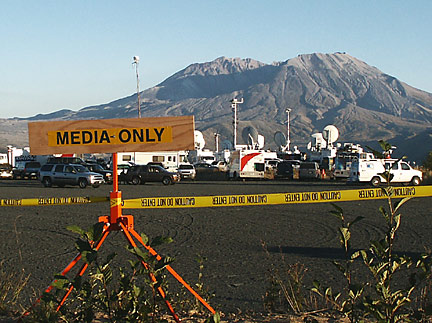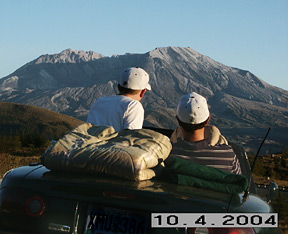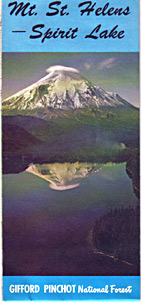

My family and I arrived late on the evening of October 4, 2004. Mt. St. Helens had put out some big clouds during the previous 24 hours and everyone was hoping for an even bigger show. High up on the main access road, we discovered that "The Media" had definitely beaten us there. They were encamped in their own reserved prime area at about 3,500 feet elevaton... Satellite antennas were everywhere. But that evening even binoculars revealed no action on the upper mountain.

Here, two young men from Eastern Oregon have their feet 'way up as they relax in their sporty black convertible. It's late afternoon, it's a spectacularly clear early Fall day. ..... We're all parked a few miles below (to the west of) the Johnston Ridge Overlook....Sadly for these guys, no more puffs of steams appeared that evening (Monday).... But Tuesday morning a very impressive steam/ash plume arose to tower over the mountain. I doubt that they waited that long. My family and I lasted until about 10 p.m., but eventually the cold and boredom drove us back to Portland so we also missed any "action."
One of the great losses caused by the
1980 eruption of St. Helens was the loss of Spirit Lake, sent
into oblivion by the main blast of the explosion. So massive was the debris avalanche that inundated the lake and
its virgin forests that the elevation of the entire lake bottom
was raised nearly 300 feet.... Prior to its demise, the large,
1,300 acre, 190 foot deep lake was famed throughout the West as
one of America's classic beauty spots; several summer camps for
children lined its shores. In the image to the left, the Lake's
perfection is complemented by the lovely classic strato-volcano
shape of the pre-eruption peak. At 9,677 feet, it was clad with
year-round snow and glaciers.... Northwesterners were so lulled
by the peak's quiet beauty that in 1915 the US Forest Service
constructed one of its classic 12x12 ft. D-6 cupola type lookouts
on the summit of the mountain, and manned it for eleven years.
(click to see a similar lookout
still in use today).
So massive was the debris avalanche that inundated the lake and
its virgin forests that the elevation of the entire lake bottom
was raised nearly 300 feet.... Prior to its demise, the large,
1,300 acre, 190 foot deep lake was famed throughout the West as
one of America's classic beauty spots; several summer camps for
children lined its shores. In the image to the left, the Lake's
perfection is complemented by the lovely classic strato-volcano
shape of the pre-eruption peak. At 9,677 feet, it was clad with
year-round snow and glaciers.... Northwesterners were so lulled
by the peak's quiet beauty that in 1915 the US Forest Service
constructed one of its classic 12x12 ft. D-6 cupola type lookouts
on the summit of the mountain, and manned it for eleven years.
(click to see a similar lookout
still in use today).
Timbora Eruption of 1815. .. In recent history, there was an eruption that made Mt. St. Helens' eruptions look like the sneezings of a baby. The Timbora eruption affected the United States far more profoundly than Mt. St. Helens ever has. Timbora's eruption was four times as powerful as the better-known Krakatoa eruption of 1883.
Timbora's location was on an island near Java and Sumatra in Idonesia... The doomed mountain was a stratovolcano standing about 14,000 feet high. After many months of awful eruptions, it blew sky high in mid-April of 1815, injecting about 100 times as much ash and sulphur up into the Earth's atmosphere as Mt. St. Helens did in its famous 1980 explosion..... The entire upper 4,000 feet of Timbora mountain was destroyed, compared with only about 1,200 feet of Mt. St. Helens. The eruption column towered far into the stratosphere, some four times higher than commericial jets fly and more than twice as high as the eruption column of St. Helens......The death toll of Timbora will probably never been known, but the best modern estimates place the human toll at 71,000 persons dead. And Timbora Volcano is not dead, volcanoloists tell us that it is only dormant....
It is not well-known that Timbora's eruption had a very adverse effect on the United States' climate the following year, causing what is known in the history books as "The Year of No Summer" (1816). The extreme amount of dust in the high stratosphere plus the sulphric acid droplets acted to greatly reduce the amount of summer warming to the point that New England had sporadic snow throughout the summer, as did areas in the Midwest. So severe were the effects that agriculture was decimated, and many areas basically were unable to plant or produce their normal crops, leading to a whole host of evil repercussions.... In Europe, food supplies became so affected that some rate 1816 as having suffered the worst famine of the 19th Century, inciting much rioting, arson and looting, and of course the inevitable epidemic of disease...... All because of a volcano on the opposite side of the World that no one even knew about!
SUPER-VOLCANOES-- believe it or not, recent studies have unearthed the sites of several "super-eruptions" which make even Timbora look puny. The largest of these occurred about 70,000-75,000 years ago. This was a time when humans were all still in Africa and beginning to thrive. But then humans appear to have had a severe setback. There is good evidence that there was a catastrophic reduction of about 60% in the human population. Many believe the die-off of humans is traceable to yet another Indonesian "caldera" type volcano, Lake Toba in Sumatra. When this caldera exploded, the volume of its eruptive material was about SEVENTEEN times more than Timbora. The unthinkably huge amount of gases and fine debris it propelled into Earth's atmosphere is thought by some researchers to have induced a "millenial" ice age (1,000 years long), with profound consequences all over the World.
It is truly sobering to realize that Portland, Seattle and indeed the World "got off easy" in 1980 with Mt. St. Helens. Hard as it is to believe if you've been to St. Helens in person, its eruption was minor compared to the potential destruction that a major volcano can unleash on its surroundings.
Mt. Mazama/Crater Lake --- here is something to challenge "Can't Happen Here" thinking! If you're thinking, "Timbora and Krakatoa were completely on the other side of the World, it can't happen here," think again! Remember 4,600 BC? Well, the Native Americans of the Pacific Northwest remember it well in their legends.... Oregon's highest mountain at the time, taller than Mt. Hood, BLEW ITS TOP OFF in a giant explosion far larger than Mt. St. Helens.... Best estimates place Mazama's eruptive power midway between that of Timbora and Krakatoa. The ancient Mt. Mazama lost the upper 5,000 feet of itself in the explosion, forming the site of Crater Lake. Click here to visit my coverage of the modern Crater Lake.... Worse yet, the Yellowstone Caldera under Yellowstone National Park is a world-class super-volcano, fully the equal of Lake Toba in the power of its past eruptions...Next time you visit the Park, look with new eyes at all those geysers, hot pools, and fumeroles and see a vast kettle on simmer!